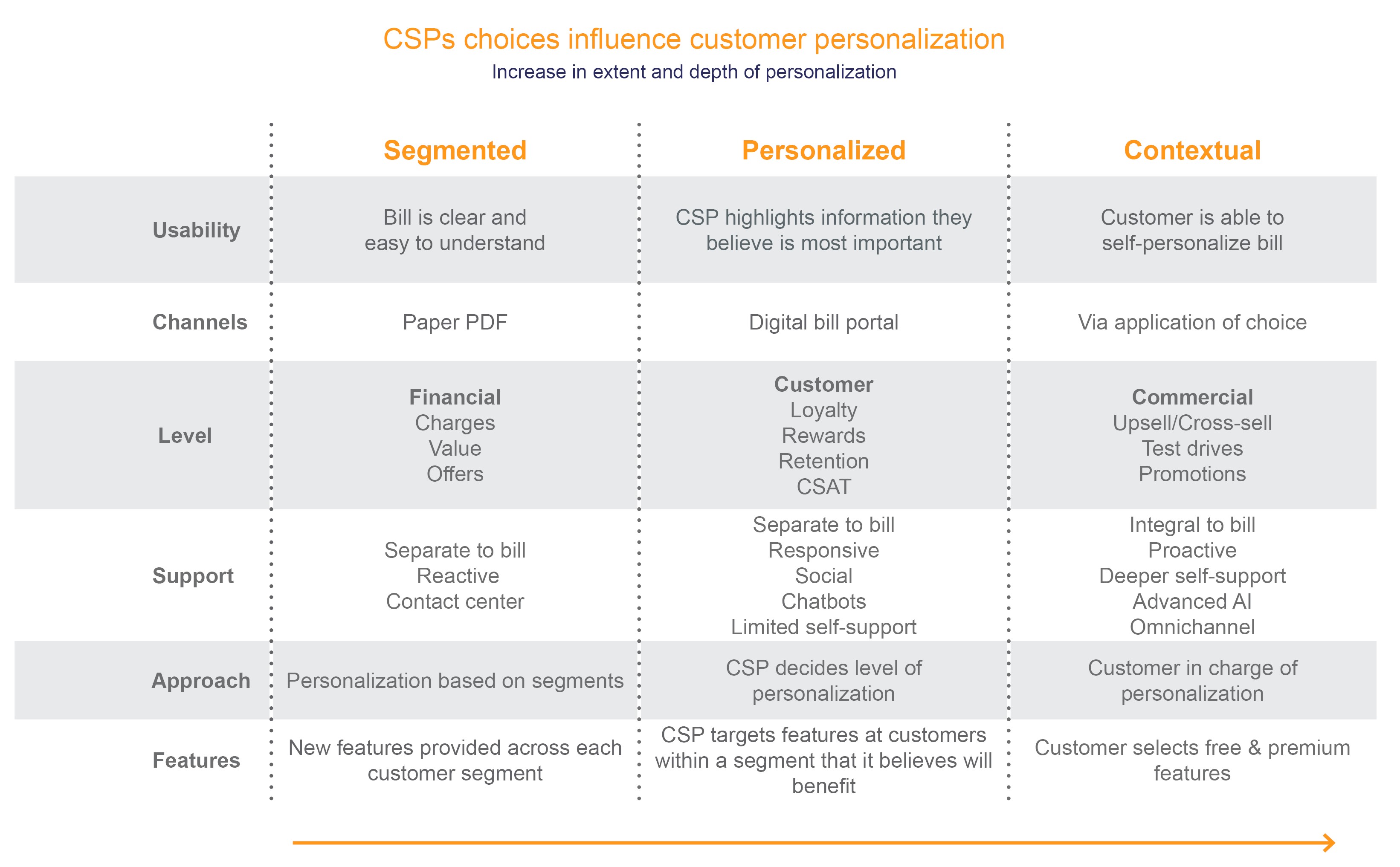Using personalization to improve Billing Experiences (BX)
20 January 2022
|
Laura Broers
Personalization has become an increasingly hot topic for marketers and customer experience professionals alike. In telecoms, CSPs have considerable potential to utilize personalization strategies to reduce churn and build a more trusted relationship with their customers. But how impactful is personalization and what does it mean within the billing context? Laura Broers investigates.
Personalization – meaning the tailoring of experiences, products and pricing to the needs of individual customers – is no longer a nice-to-have, but a basic expectation of increasingly digitally-savvy customers. It helps communications service providers (CSPs) differentiate themselves in competitive markets while delivering tangible benefits.
These tangible benefits equate to a 35% increase in customer lifetime value (CLV), according to the Boston Consulting Group. A large proportion of which derives from churn reduction – in other words, extending the customer lifecycle so that CSPs have more upsell opportunities while avoiding the huge cost of replacing them.
While there’s currently much discussion about the huge cost of new network roll out, the impact of churn on CSP bottom lines is frequently overlooked. On average CSPs spend 15-20% of their revenues acquiring and retaining customers - most of which is the cost of subscriber acquisition (SAC). A North American CSP recently illustrated just how expensive churn is for the average CSP, revealing it cost almost 50 times more to acquire a new customer than to retain an existing one.
That’s why when BCG says that effective personalization can reduce telco churn rates by 20%, telco CFOs should sit up and ask how, because even a modest reduction in churn represents a saving of tens of millions of dollars for a large CSP.
Personalization needs to meet customer expectations
As impressive as these figures are, personalization needs to meet customer expectations and this is where it can fall down.
In ‘The State of Personalization 2021’, Twilio Segment found that customer expectations of personalization are growing faster than companies’ abilities to meet them. While 85% of businesses said they now provide a “somewhat personalized experience” to their customers, only 60% of consumers agreed. This gap between what companies are providing, and what customers expect, often occurs because personalization is being delivered in a fairly narrow, shallow, and siloed manner.
Addressing this gap requires CSPs to extend personalization across all customer touchpoints, and provide deeper and more meaningful personalization that goes beyond just getting the name correct at the top of the bill. Personalization initiatives should be linked to KPIs such as churn reduction, and address frequent pain points (such as billing), demonstrating an understanding of customer needs in order to build loyalty.

How personalization can be applied to billing
Applying effective personalization strategies to billing has huge potential to positively impact business performance and customer relationships. To transform the bill from a churn agent into a retention tool that helps build strong relationships with their customers, CSPs need to bear six things in mind.
-
Bill personalization needs to be meaningful: this means CSPs need to identify which pieces of information are important to individual customers, and adjust bill formats to reflect the information they are most interested in. CSPs can identify which data is meaningful to their customers based on what they have used or viewed in the past. One customer might be interested in saving money, for example, while another may wish to know how much of their data allowance they used.
-
Personalization should be permission-based: in the rush to be helpful, it’s possible to personalize too much (or in a non-meaningful or erroneous way). Offering customers the option to opt-in to new features reinforces the added value CSPs are delivering, as well as avoiding the feeling of intrusiveness.
-
Understand the power of self-personalization in the onboarding stage: providing customers with the tools to personalize their own BX journey is a powerful strategy. It avoids the pitfall of assumptions – where CSPs try to guess what the customer wants from historic behavior. Offering self-personalization in the first stage of the customer journey (at onboarding) is a great way to engage your customers and show you care about them. For example, business customers should be able to select how they want to receive their billing data, such as via a PDF bill emailed to them, a raw data Excel file, or sent in UBL via PEPPOL.
-
Go beyond charges: in addition to using personalization to provide higher levels of clarity to charges, CSPs can use the bill as a personalized loyalty tool. The first step is to highlight meaningful information (such as cost savings), but beyond this CSPs can create personalized offers and reward loyalty with discounts, free services, or exclusive previews of new products promoted to individual customers through their bill.
-
Personalize the whole journey, not just part of it: To be effective, personalization cannot be implemented in silos but must extend across the whole customer journey. If bills are personalized, the support that comes with them must also be personalized. Preferred interaction channels should be available from within the bill, and the CSP should also understand the value of the customer, their history, preferences and pain points, in order to tailor support and avoid the frustration of customers having to repeat information to customer service representatives.
-
Some customers need more or different help: Personalization means meeting the needs of individual customers, which requires CSPs to ensure that bills are fully accessible. CSPs should ensure their bills are compliant with accessibility standards such as WCAG 2.1 and that they are aware of specific needs an individual customer might have, rather than taking a generic approach to service and support.
The billing experience is an integral element of the end-to-end customer journey that also needs to be personalized to customers’ needs. Applying deeper personalization to BX is a key strategy that CSPs can use to drive business performance, retain more customers, increase satisfaction, and position to realize more customer lifetime value.
For those CSPs interested in exploring the business potential of personalization or applying it to either their B2C or B2B billing experience, contact us to find out how our business consultants can help you isolate and define the benefits to deliver a more personalized BX to your business.






